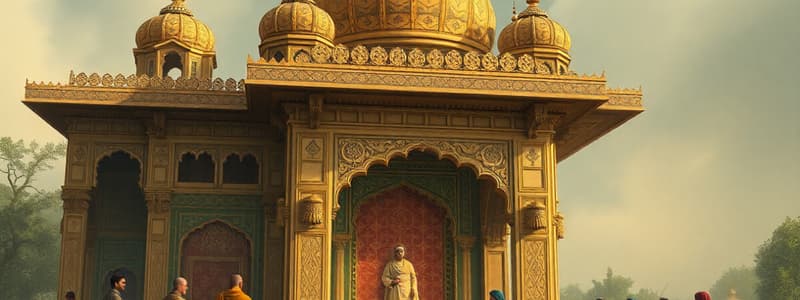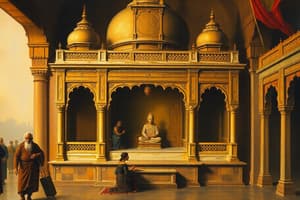Podcast
Questions and Answers
What are the two main lineages from which the Mughals descended?
What are the two main lineages from which the Mughals descended?
- Timur and Babur
- Babur and Akbar
- Genghis Khan and Timur (correct)
- Genghis Khan and Alexander the Great
Why did the Mughals prefer not to be called Mughals or Mongols?
Why did the Mughals prefer not to be called Mughals or Mongols?
- To align themselves with the Uzbegs
- Because they were from India
- Because they wanted to distance themselves from their ancestry
- Due to the negative association with Genghis Khan's conquests (correct)
In a painting representing their lineage, who appears to be in the center?
In a painting representing their lineage, who appears to be in the center?
- Babur
- Aurangzeb
- Akbar
- Timur (correct)
Which Mughal emperors are illustrated as positioned to the right of Timur in the painting?
Which Mughal emperors are illustrated as positioned to the right of Timur in the painting?
Which lineage was represented on the left side of Timur in the painting?
Which lineage was represented on the left side of Timur in the painting?
What was a significant challenge faced by the Mughal Empire during its rule?
What was a significant challenge faced by the Mughal Empire during its rule?
Which time period marks the significant expansion of the Mughal Empire?
Which time period marks the significant expansion of the Mughal Empire?
What was the main influence of the Mughal Empire on subsequent rulers?
What was the main influence of the Mughal Empire on subsequent rulers?
Where does the Prime Minister of India deliver the Independence Day address?
Where does the Prime Minister of India deliver the Independence Day address?
Which statement about the Mughal Empire is true?
Which statement about the Mughal Empire is true?
What is the primary role of a mansabdar within the Mughal Empire?
What is the primary role of a mansabdar within the Mughal Empire?
How is the salary of a mansabdar determined?
How is the salary of a mansabdar determined?
What differentiates a mansabdar from a muqtis regarding the administration of their jagirs?
What differentiates a mansabdar from a muqtis regarding the administration of their jagirs?
What does a higher zat value denote for a mansabdar?
What does a higher zat value denote for a mansabdar?
During which reign did the number of mansabdars with a zat of 5,000 increase from 29 to 79?
During which reign did the number of mansabdars with a zat of 5,000 increase from 29 to 79?
Which inheritance system did the Mughals practice, differing from the rule of primogeniture?
Which inheritance system did the Mughals practice, differing from the rule of primogeniture?
What was a common response from Rajput rulers towards Mughal authority as it grew?
What was a common response from Rajput rulers towards Mughal authority as it grew?
Which of the following statements accurately reflects the maternal lineage of Jahangir and Shah Jahan?
Which of the following statements accurately reflects the maternal lineage of Jahangir and Shah Jahan?
Which two Mughal rulers are associated with the military campaigns depicted in the map?
Which two Mughal rulers are associated with the military campaigns depicted in the map?
In which regions were key military campaigns led that are marked in the map under Akbar and Aurangzeb?
In which regions were key military campaigns led that are marked in the map under Akbar and Aurangzeb?
What was the primary function of the zamindars in the Mughal revenue system?
What was the primary function of the zamindars in the Mughal revenue system?
Which aspect of Akbar's revenue system was primarily focused on crop yields and taxation?
Which aspect of Akbar's revenue system was primarily focused on crop yields and taxation?
During which ruler's reign did the problem of declining revenue collections become most pronounced?
During which ruler's reign did the problem of declining revenue collections become most pronounced?
What challenge did the increase in the number of mansabdars create during the Mughal Empire?
What challenge did the increase in the number of mansabdars create during the Mughal Empire?
What method did Todar Mal use to manage the taxation of crops during Akbar's reign?
What method did Todar Mal use to manage the taxation of crops during Akbar's reign?
What significance did the Mughals attach to their Timurid ancestry?
What significance did the Mughals attach to their Timurid ancestry?
What is the purpose of the pictorial representations made by each Mughal ruler?
What is the purpose of the pictorial representations made by each Mughal ruler?
In what way can the Mughal practice of creating portraits be compared to modern customs?
In what way can the Mughal practice of creating portraits be compared to modern customs?
Which event is significant in the Mughal lineage regarding their ancestry?
Which event is significant in the Mughal lineage regarding their ancestry?
What aspect of Mughal military campaigns can be inferred from the depicted image?
What aspect of Mughal military campaigns can be inferred from the depicted image?
What concept did Akbar introduce that emphasized tolerance among different religious groups?
What concept did Akbar introduce that emphasized tolerance among different religious groups?
Which individual played a significant role in helping Akbar develop his vision of governance based on universal peace?
Which individual played a significant role in helping Akbar develop his vision of governance based on universal peace?
Which of the following features might indicate the importance of the gathering depicted in the image?
Which of the following features might indicate the importance of the gathering depicted in the image?
What was one of Akbar’s cultural contributions apart from promoting religious tolerance?
What was one of Akbar’s cultural contributions apart from promoting religious tolerance?
Which historical figure was likely depicted among the learned individuals in Jahangir's court, known for their role in religious discourse?
Which historical figure was likely depicted among the learned individuals in Jahangir's court, known for their role in religious discourse?
What was the primary purpose of the Ain-i Akbari in the Akbar Nama?
What was the primary purpose of the Ain-i Akbari in the Akbar Nama?
Who was tasked with writing the three-volume history of Akbar's reign?
Who was tasked with writing the three-volume history of Akbar's reign?
What administrative role did the subadar play in the provinces?
What administrative role did the subadar play in the provinces?
What type of information was included in the Ain-i Akbari?
What type of information was included in the Ain-i Akbari?
Who was responsible for maintaining peace and order in the provinces under the subadar?
Who was responsible for maintaining peace and order in the provinces under the subadar?
What percentage of the empire's total revenue was received as salaries by only 445 of 8,000 high-ranking officials?
What percentage of the empire's total revenue was received as salaries by only 445 of 8,000 high-ranking officials?
What was a significant economic issue faced by primary producers during the Mughal Empire's prosperous time?
What was a significant economic issue faced by primary producers during the Mughal Empire's prosperous time?
As the authority of the Mughal emperor declined, what did regional dynasties in Hyderabad and Awadh begin to do?
As the authority of the Mughal emperor declined, what did regional dynasties in Hyderabad and Awadh begin to do?
Who primarily benefited from the significant spending of the Mughal elite during this period?
Who primarily benefited from the significant spending of the Mughal elite during this period?
What contradiction was noted by international travelers regarding the Mughal Empire during its era of wealth?
What contradiction was noted by international travelers regarding the Mughal Empire during its era of wealth?
Flashcards
Mughal Empire
Mughal Empire
The Mughal Empire was a powerful and large kingdom in the Indian subcontinent during the Middle Ages.
Expansion of the Mughal Empire
Expansion of the Mughal Empire
The Mughals were successful in expanding their kingdom across the Indian subcontinent, controlling almost the entire region.
Mughal Administration
Mughal Administration
The Mughal Empire developed efficient and sophisticated administration systems to govern their vast kingdom.
Mughal Governance Models
Mughal Governance Models
Signup and view all the flashcards
Red Fort
Red Fort
Signup and view all the flashcards
Who were the Mughals?
Who were the Mughals?
Signup and view all the flashcards
What lineages did the Mughals descend from?
What lineages did the Mughals descend from?
Signup and view all the flashcards
Why did the Mughals dislike being called 'Mughals' or 'Mongols'?
Why did the Mughals dislike being called 'Mughals' or 'Mongols'?
Signup and view all the flashcards
Who were some notable Mughal emperors?
Who were some notable Mughal emperors?
Signup and view all the flashcards
What does the painting depict?
What does the painting depict?
Signup and view all the flashcards
Mughal Ancestry
Mughal Ancestry
Signup and view all the flashcards
Mughal Lineage Commemoration
Mughal Lineage Commemoration
Signup and view all the flashcards
Visual Propaganda
Visual Propaganda
Signup and view all the flashcards
Mughal Military Campaigns
Mughal Military Campaigns
Signup and view all the flashcards
Visual Symbolism
Visual Symbolism
Signup and view all the flashcards
Coparcenary Inheritance
Coparcenary Inheritance
Signup and view all the flashcards
Rajputs
Rajputs
Signup and view all the flashcards
Primogeniture in Mughal Succession
Primogeniture in Mughal Succession
Signup and view all the flashcards
Coparcenary Inheritance - Mughal Practice
Coparcenary Inheritance - Mughal Practice
Signup and view all the flashcards
Mughal Alliances with Rajputs
Mughal Alliances with Rajputs
Signup and view all the flashcards
Mansabdar System
Mansabdar System
Signup and view all the flashcards
Zat
Zat
Signup and view all the flashcards
Jagir
Jagir
Signup and view all the flashcards
Sawar
Sawar
Signup and view all the flashcards
Increase in Mansabdars with High Zat
Increase in Mansabdars with High Zat
Signup and view all the flashcards
What was Akbar's revenue system called?
What was Akbar's revenue system called?
Signup and view all the flashcards
How did the Mughals collect revenue from peasants?
How did the Mughals collect revenue from peasants?
Signup and view all the flashcards
What challenge did the Mughals face with revenue collection during Aurangzeb's reign?
What challenge did the Mughals face with revenue collection during Aurangzeb's reign?
Signup and view all the flashcards
How did an increase in the number of mansabdars impact revenue collection?
How did an increase in the number of mansabdars impact revenue collection?
Signup and view all the flashcards
What ultimately led to the hardship for peasants during Aurangzeb's reign?
What ultimately led to the hardship for peasants during Aurangzeb's reign?
Signup and view all the flashcards
Mughal Wealth Inequality
Mughal Wealth Inequality
Signup and view all the flashcards
Impact of Mughal Spending
Impact of Mughal Spending
Signup and view all the flashcards
Mughal Elite & Regional Dynasties
Mughal Elite & Regional Dynasties
Signup and view all the flashcards
Mughal Wealth & Poverty
Mughal Wealth & Poverty
Signup and view all the flashcards
Mughal Revenue System & Investment
Mughal Revenue System & Investment
Signup and view all the flashcards
Sulh-i Kul
Sulh-i Kul
Signup and view all the flashcards
Akbar's System of Ethics
Akbar's System of Ethics
Signup and view all the flashcards
Abul Fazl
Abul Fazl
Signup and view all the flashcards
Jahangir
Jahangir
Signup and view all the flashcards
Translation of Sanskrit Works
Translation of Sanskrit Works
Signup and view all the flashcards
What is the Ain-i Akbari?
What is the Ain-i Akbari?
Signup and view all the flashcards
How was the Mughal empire organized?
How was the Mughal empire organized?
Signup and view all the flashcards
What were the responsibilities of the subadar?
What were the responsibilities of the subadar?
Signup and view all the flashcards
Who was the diwan?
Who was the diwan?
Signup and view all the flashcards
Who wrote the Akbar Nama?
Who wrote the Akbar Nama?
Signup and view all the flashcards




